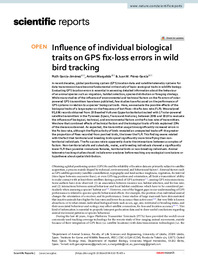Por favor, use este identificador para citar o enlazar este ítem:
https://hdl.handle.net/11000/31150Registro completo de metadatos
| Campo DC | Valor | Lengua/Idioma |
|---|---|---|
| dc.contributor.author | García Jiménez, Ruth | - |
| dc.contributor.author | Margalida, Antoni | - |
| dc.contributor.author | Pérez-García, Juan Manuel | - |
| dc.contributor.other | Departamentos de la UMH::Biología Aplicada | es_ES |
| dc.date.accessioned | 2024-02-06T12:14:09Z | - |
| dc.date.available | 2024-02-06T12:14:09Z | - |
| dc.date.created | 2020 | - |
| dc.identifier.citation | Scientific Reports volume 10, Article number: 19621 (2020) | es_ES |
| dc.identifier.issn | 2045-2322 | - |
| dc.identifier.uri | https://hdl.handle.net/11000/31150 | - |
| dc.description.abstract | In recent decades, global positioning system (GPS) location data and satellite telemetry systems for data transmission have become fundamental in the study of basic ecological traits in wildlife biology. Evaluating GPS location errors is essential in assessing detailed information about the behaviour of an animal species such as migration, habitat selection, species distribution or foraging strategy. While many studies of the infuence of environmental and technical factors on the fx errors of solarpowered GPS transmitters have been published, few studies have focussed on the performance of GPS systems in relation to a species’ biological traits. Here, we evaluate the possible efects of the biological traits of a large raptor on the frequency of lost fxes—the fx-loss rate (FLR). We analysed 95,686 records obtained from 20 Bearded Vultures Gypaetus barbatus tracked with 17 solar-powered satellite transmitters in the Pyrenees (Spain, France and Andorra), between 2006 and 2019 to evaluate the infuence of biological, technical, and environmental factors on the fx-loss rate of transmitters. We show that combined efects of technical factors and the biological traits of birds explained 23% of the deviance observed. As expected, the transmitter usage time signifcantly increased errors in the fx-loss rate, although the fight activity of birds revealed an unexpected trade-of: the greater the proportion of fxes recorded from perched birds, the lower the FLR. This fnding seems related with the fact that territorial and breeding birds spend signifcantly more time fying than nonterritorial individuals. The fx success rate is apparently due to the interactions between a complex of factors. Non-territorial adults and subadults, males, and breeding individuals showed a signifcantly lower FLR than juveniles-immatures females, territorial birds or non-breeding individuals. Animal telemetry tracking studies should include error analyses before reaching any ecological conclusions or hypotheses about spatial distribution. | es_ES |
| dc.format | application/pdf | es_ES |
| dc.format.extent | 10 | es_ES |
| dc.language.iso | eng | es_ES |
| dc.publisher | Nature Research | es_ES |
| dc.rights | info:eu-repo/semantics/openAccess | es_ES |
| dc.rights | Attribution-NonCommercial-NoDerivatives 4.0 Internacional | * |
| dc.rights.uri | http://creativecommons.org/licenses/by-nc-nd/4.0/ | * |
| dc.subject.classification | Ecología | es_ES |
| dc.subject.other | CDU::5 - Ciencias puras y naturales::57 - Biología::574 - Ecología general y biodiversidad | es_ES |
| dc.title | Infuence of individual biological traits onGPS fx‑loss errors in wild bird tracking | es_ES |
| dc.type | info:eu-repo/semantics/article | es_ES |
| dc.relation.publisherversion | https://doi.org/10.1038/s41598-020-76455-x | es_ES |

Ver/Abrir:
9- Garcia Jimenez et al. 2020 Sci Rep.pdf
1,15 MB
Adobe PDF
Compartir:
 La licencia se describe como: Atribución-NonComercial-NoDerivada 4.0 Internacional.
La licencia se describe como: Atribución-NonComercial-NoDerivada 4.0 Internacional.
.png)